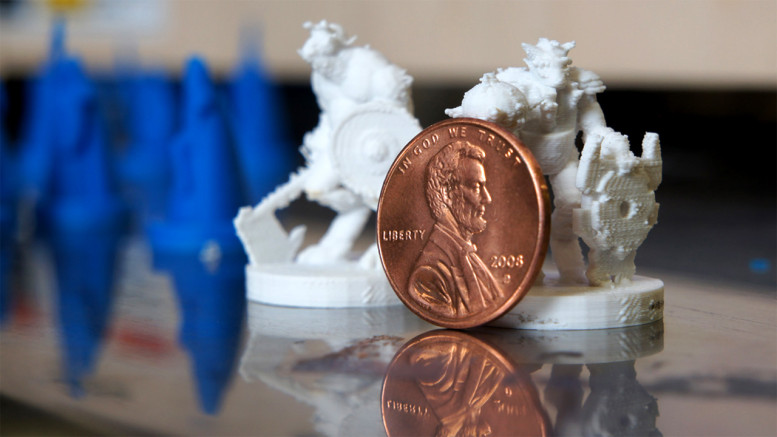In the 1960s Star Trek television program, crew members would head into the cafeteria and push a couple of buttons on a “replicator” and within seconds they would reach into the box and pull out their meal.
This was great science fiction, but could it ever be reality? It appears that 3D printing may make a form of the “replicator” a reality. Today, an operator loads a software program into a 3D printer and hours later, the operator removes an object from the 3D printer. The technology is advancing rapidly and has the potential to be a disrupting force to the world’s manufacturing system.
Perhaps if we think about the evolution of the Star Trek “communicator” and how much more powerful our cell phones are than anything imagined in the 1960s, we can develop a picture of what 3D printing may look like in the future. I believe that the 3D printer has the potential to be as disruptive to manufacturing as the cell phone has been to communication.
Virtually every manufacturing facility is part of a global supply chain. 3D printing has the potential to move production into the local market. Instead of having to go to a store or get on the Internet to purchase a guide to replace the one that broke in a kitchen drawer, you simply download the plan to your 3D printer in the garage and print it.
Consumers would not have to be worried about the availability of parts. Additionally, 3D printers allow for the part to be customized to fit the specific drawer, color or style that the consumer prefers. Nike has filed multiple patents for printing shoes, and Gillette has filed patents for razor cartridges. We are already seeing the customization aspects, and the next logical step would be for consumers to have their own production model printers.
In the medical field, doctors are using 3D printers to produce joint replacements that are customized to the patient. Our society has come to expect customization through the use of data in our online experience and the same transformation can occur in manufactured goods due to 3D printing.
3D printing has been limited by types of materials and size of printers. This is changing rapidly in both directions – large and small. Two companies in China, Winsun and Zhouda Group, are experimenting with 3D printed houses.
Initially most of the structures were printed from a concrete base. In a demonstration, Winsun printed and assembled 10 one-room houses in 24 hours utilizing recycled waste and cement. Last summer, Zhouda group utilized a “secret” material to print modules that were assembled into a two-story villa in three hours. Zhouda is protective of the material and prints the modules in a factory and then transports them to the construction site.
The resulting building is reportedly able to withstand a magnitude-9 earthquake and to resist fire. This has the potential to transform the construction industry. Local Motors has printed and demonstrated a 3D printed car. Everything on the electric car, named the Strati, which could be printed as one piece was, and in just 44 hours, the car was manufactured using a large 3D printer.
The other direction of 3D printing is the impact of nano-technology. A team at Harvard University has printed a lithium-ion battery. That is not a big deal, except that it is the size of a grain of sand and works like a normal battery. It could be used to power medical devices and other micro and nano devices. When connected with advances in bioprinting, the impact on the treatment of diseases and other human ailments have the potential to transform.
The next advance in 3D printing is 4D printing. 4D printing works with materials that can transform based on environmental stimuli such as moisture or heat. Some futurists suggest that this could lead to self-assembling robots, but presently it is about changing shapes.
We could use 4D printing to print shoes that become waterproof in the rain or sprout cleats on grass. It could be used to print hydraulic pipes that repair themselves when a leak is detected. The possibilities are endless. The future is bright, and the entrepreneurial spirit is strong.
As 3D printers become more versatile, cheaper and integrated into our society, entrepreneurs will continue to develop new products and uses for them. Will you be ready for the disruption in manufacturing that 3D printers have ignited?
Dr. Joel Welch worked as a consulting engineer for 9-1/2 years before joining the faculty at Greenville Technical College (GTC) in 1998. At GTC, Joel has served as a faculty member, department head, dean for Engineering Technology, associate vice president for administration, and currently as dean of the Business and Technology division. During his career, he has built strong partnerships with business and industry as well as other educators to meet workforce needs. Joel earned a bachelor’s degree in Civil Engineering from The Citadel, a master’s degree in Civil Engineering from the University of South Carolina, and a Ph.D. in Educational Leadership from Clemson University. Active in the community, he has served on the Greer Middle College High School Board and the SC Skills USA Board. He is a current member and past-president of the Pleasantburg Rotary Club, and he directs a youth drama team. He and his wife, Lisa, have lived in the Greer area for the past 22 years and are the parents of 3 children.



Be the first to comment on "The Future of 3D Printing/Additive Manufacturing"